Transurban Group Bundle
How Does Transurban Group Navigate the Toll Road Race?
The infrastructure sector is experiencing a major shift, fueled by urban growth and tech innovations. Transurban Group, a key Transurban Group SWOT Analysis, is at the forefront, managing urban toll road networks. Established in 1996, the company has grown from its Australian roots to become a global leader in transportation solutions.
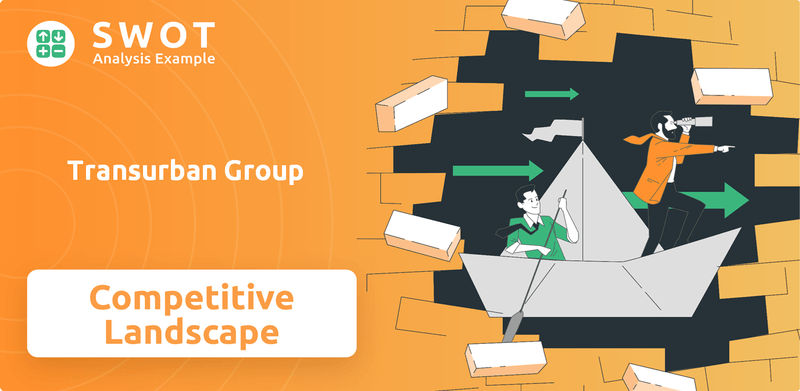
This exploration of Transurban Group will dissect its competitive landscape, providing a detailed market analysis. We will examine its primary rivals and understand how this infrastructure company maintains its edge. Furthermore, we'll explore Transurban Group's strategic partnerships, its toll road projects, and its competitive positioning in the market, offering valuable insights for investors and industry observers.
Where Does Transurban Group’ Stand in the Current Market?
Transurban Group, a leading infrastructure company, holds a strong market position in the toll road industry. Its core operations focus on the development, operation, and maintenance of urban toll road networks. These networks are designed to ease congestion and improve travel times for commuters and commercial operators.
The company's value proposition centers on providing efficient and reliable transportation solutions. This is achieved through strategic investments in large-scale projects and the integration of advanced technologies like electronic tolling. Transurban's focus on high-value urban corridors and technological advancements contributes to its robust financial health.
Transurban's financial performance in late 2023 showed significant growth. Proportional toll revenue increased by 13.9% to $3,212 million, and proportional EBITDA rose by 14.8% to $2,586 million. The company also reported a substantial increase in free cash flow, up 26.6% to $1,570 million, highlighting its strong financial stability and operational efficiency.
Transurban has a significant presence in major Australian cities, including Melbourne, Sydney, and Brisbane. It has also expanded its operations into North America, particularly in the Greater Washington Area in the United States and Montreal, Canada. This diversified geographic footprint supports its overall market position.
Transurban serves a diverse customer base, including individual commuters and commercial freight operators. The company's ability to cater to a wide range of users seeking efficient and reliable transportation solutions is key to its market success. This diverse customer base helps stabilize revenue streams.
The integration of advanced technologies, such as electronic tolling and intelligent transport systems, enhances user experience and operational efficiency. These technologies are crucial for maintaining a competitive edge and improving the overall performance of its toll road networks. This focus on technology contributes to its robust financial health.
Transurban strategically focuses on large-scale, high-value urban corridors. This strategic focus allows the company to maximize revenue potential and maintain a competitive advantage within the toll road market. This approach helps to create long-term, stable revenue streams.
For a deeper dive into how Transurban generates revenue and its business model, you can explore Revenue Streams & Business Model of Transurban Group.
Transurban's competitive positioning is strengthened by its focus on high-value urban corridors, technological integration, and strong financial performance. These factors contribute to its ability to maintain a leading position in the toll road industry and generate stable revenue streams. The company's strategic approach and operational excellence are key differentiators.
- Dominant market share in key regions, particularly Australia.
- Advanced technology integration for operational efficiency.
- Strong financial performance with consistent revenue growth.
- Strategic focus on high-value urban corridors.
Transurban Group SWOT Analysis
- Complete SWOT Breakdown
- Fully Customizable
- Editable in Excel & Word
- Professional Formatting
- Investor-Ready Format
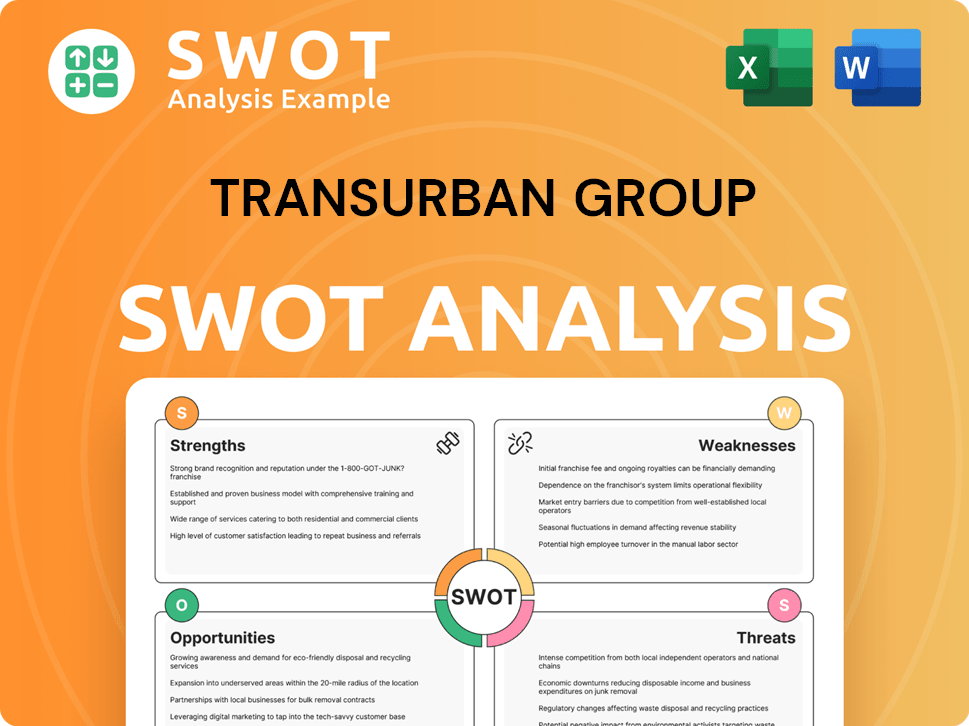
Who Are the Main Competitors Challenging Transurban Group?
The competitive landscape for Transurban Group, an infrastructure company, is shaped by both direct and indirect competitors. Direct competition primarily comes from other private infrastructure developers and operators, as well as government-owned entities managing toll roads. These rivals vie for projects, concessions, and market share in the toll road sector.
Indirect competition includes entities offering alternative transportation solutions, such as smart city initiatives, which could reduce reliance on traditional road networks. The industry also sees frequent mergers, acquisitions, and strategic alliances that further define the competitive dynamics. Understanding these factors is crucial for a thorough market analysis.
Transurban Group faces significant competition in the toll roads sector. Key competitors include private infrastructure developers and operators, alongside government-owned entities. Atlas Arteria, operating toll roads internationally, is a direct competitor. Globally, companies like Abertis and Vinci Autoroutes also compete for large-scale infrastructure projects.
Atlas Arteria: Operates toll roads internationally, competing for new concessions. State-owned road authorities in Australia: Represent key rivals in specific regions.
Abertis (Spain): Competes for large-scale infrastructure projects. Vinci Autoroutes (France): Also competes for major toll road projects and expansions.
Other private toll road operators: Compete for projects in North America. State transportation departments: Also involved in project bidding and management.
Smart city solutions providers: Offer alternative transportation options. Integrated mobility services: Indirectly challenge traditional road networks.
Concession agreements: Intense competition for lucrative agreements. Mergers and alliances: Shape the competitive landscape through consortiums.
Financial capacity: Crucial for bidding on large projects. Technological capabilities: Important for efficient operations and innovation. Project delivery experience: Essential for managing complex infrastructure projects.
The Marketing Strategy of Transurban Group involves navigating a complex competitive environment. The company's success hinges on its ability to secure and manage toll road projects while facing challenges from various competitors. The competitive positioning of Transurban Group is influenced by its ability to secure favorable concession agreements and its operational efficiency.
The competitive landscape for Transurban Group is shaped by several key factors:
- Financial Strength: Capacity to fund large infrastructure projects.
- Technological Innovation: Implementing smart road technologies.
- Operational Efficiency: Managing toll roads effectively.
- Strategic Partnerships: Collaborating on projects and bids.
- Geographic Diversification: Expanding into new markets.
Transurban Group PESTLE Analysis
- Covers All 6 PESTLE Categories
- No Research Needed – Save Hours of Work
- Built by Experts, Trusted by Consultants
- Instant Download, Ready to Use
- 100% Editable, Fully Customizable
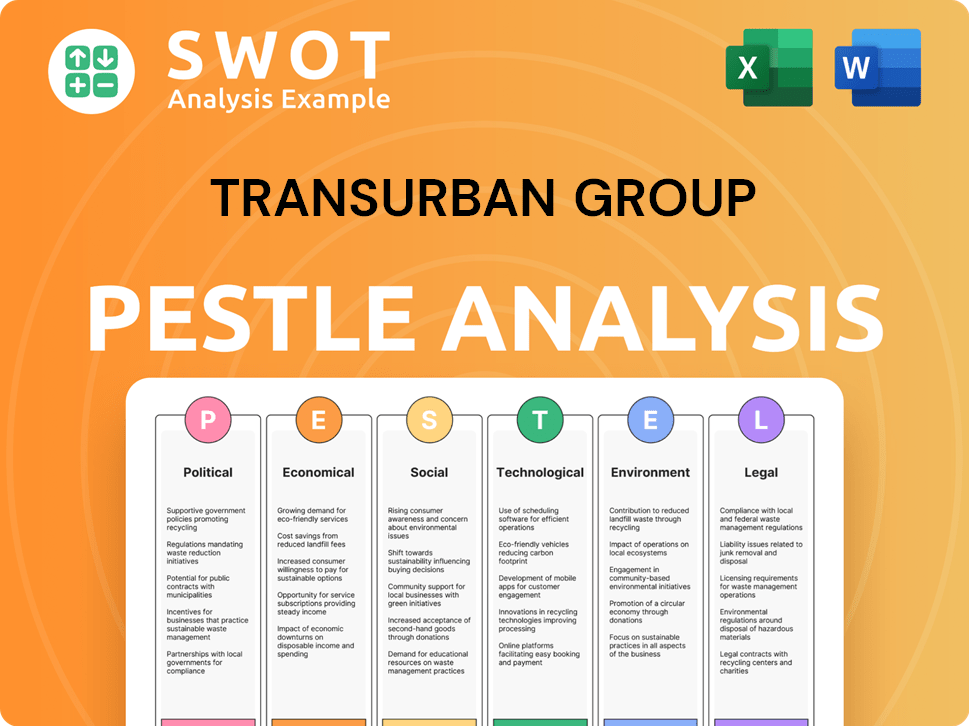
What Gives Transurban Group a Competitive Edge Over Its Rivals?
The competitive advantages of Transurban Group are primarily rooted in its extensive experience, strategic asset portfolio, and technological leadership within the toll road sector. As a leading infrastructure company, Transurban has cultivated a strong market position, particularly in Australia, through its interconnected toll road systems. This network effect enhances customer loyalty and creates significant barriers to entry for potential competitors. Understanding the Growth Strategy of Transurban Group is crucial for appreciating its competitive edge.
Transurban's long-term concession agreements, often spanning decades, provide stable and predictable revenue streams, differentiating it from rivals with shorter-term contracts. Proprietary technologies and intellectual property in electronic tolling systems, traffic management, and intelligent transport systems (ITS) further set Transurban apart. These innovations enhance operational efficiency and improve customer satisfaction, making its roads more attractive to users.
The company's strong relationships with government bodies and its proven track record in delivering complex infrastructure projects also represent a significant advantage, often positioning it favorably for new project bids. These advantages have evolved from simply operating roads to becoming integrated mobility solution providers. While some operational aspects can be imitated, the sheer scale of Transurban's network, its deep institutional knowledge, and its continuous investment in technology create substantial barriers to entry for potential competitors, making its advantages largely sustainable in the medium to long term.
Transurban's interconnected toll road systems create a network effect, enhancing customer loyalty. This strengthens its market position in key urban centers, particularly in Australia. The company's ability to offer seamless travel experiences is a significant competitive advantage.
Transurban benefits from long-term concession agreements, providing stable revenue streams. These agreements, often spanning decades, offer predictability and differentiate the company from competitors with shorter-term contracts. This stability supports long-term strategic planning and investment.
Proprietary technologies in electronic tolling, traffic management, and ITS set Transurban apart. These innovations improve operational efficiency and customer satisfaction. For example, real-time data analytics enhances network utilization.
Strong relationships with government bodies and a proven track record are key advantages. Transurban's ability to deliver complex infrastructure projects positions it favorably for new bids. This expertise enhances its competitive positioning in the market.
Transurban's competitive advantages are multifaceted, encompassing its established network, technological prowess, and strategic partnerships. These advantages contribute to its strong market position and ability to generate consistent revenue. The company's focus on innovation and operational efficiency further strengthens its position in the toll roads market.
- Extensive experience in the toll road sector.
- Strategic asset portfolio, including long-term concession agreements.
- Technological leadership in electronic tolling and traffic management.
- Strong relationships with government bodies.
- Proven track record in delivering complex infrastructure projects.
Transurban Group Business Model Canvas
- Complete 9-Block Business Model Canvas
- Effortlessly Communicate Your Business Strategy
- Investor-Ready BMC Format
- 100% Editable and Customizable
- Clear and Structured Layout
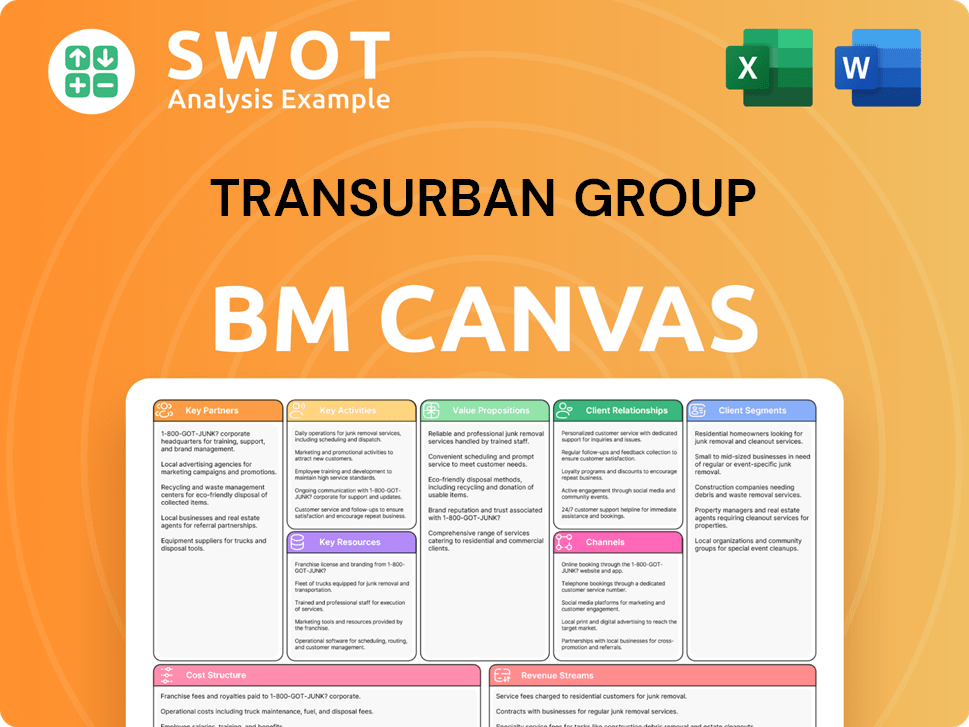
What Industry Trends Are Reshaping Transurban Group’s Competitive Landscape?
The toll road industry is currently undergoing significant shifts, influenced by urbanization, technological advancements, and sustainability concerns. As an infrastructure company, the competitive landscape for Transurban Group is shaped by these trends, demanding strategic adaptation and innovation. Understanding these dynamics is crucial for assessing the company's future prospects and investment potential. This article provides a comprehensive market analysis of Transurban Group, focusing on the competitive landscape, industry trends, and future outlook.
The company's success hinges on its ability to navigate the evolving transportation sector, manage risks, and capitalize on emerging opportunities. This involves not only maintaining its current toll road assets but also exploring new avenues for growth and diversification. This analysis will provide insights into the challenges and opportunities that Transurban Group faces.
Rapid urbanization and population growth are key drivers of demand for efficient transportation infrastructure, specifically toll roads. The increasing adoption of Intelligent Transport Systems (ITS) is improving traffic management and operational efficiency. There's also a growing emphasis on sustainability, with a push towards greener construction methods and energy-efficient operations.
Technological advancements like connected and autonomous vehicles pose both challenges and opportunities. Regulatory changes, particularly those related to environmental impact and urban planning, could require strategic adaptation. Competition from alternative transportation modes, such as expanded public transport, could reduce reliance on private vehicles.
Transurban can expand its existing networks and develop new corridors to capitalize on urbanization. The company can integrate new technologies into road designs and operations. There are opportunities to diversify service offerings, potentially integrating toll roads with broader urban mobility solutions.
The company's competitive position is evolving towards a more integrated mobility provider. This involves leveraging data and technology to offer a wider range of services beyond traditional tolling. This will help ensure resilience in a dynamic future.
The future of the toll road industry and Transurban Group depends on strategic adaptation to these trends and challenges. Investment in technology, sustainability, and diversification will be essential for maintaining a competitive edge. Understanding the competitive landscape and market dynamics is crucial for making informed decisions.
- Technological Integration: Integrating ITS and preparing for autonomous vehicles.
- Sustainability Focus: Implementing green construction and energy-efficient operations.
- Service Diversification: Expanding beyond tolling to include broader mobility solutions.
- Regulatory Compliance: Adapting to changing environmental and urban planning regulations.
For a deeper dive into how Transurban Group targets its customers, consider reading about the Target Market of Transurban Group.
Transurban Group Porter's Five Forces Analysis
- Covers All 5 Competitive Forces in Detail
- Structured for Consultants, Students, and Founders
- 100% Editable in Microsoft Word & Excel
- Instant Digital Download – Use Immediately
- Compatible with Mac & PC – Fully Unlocked
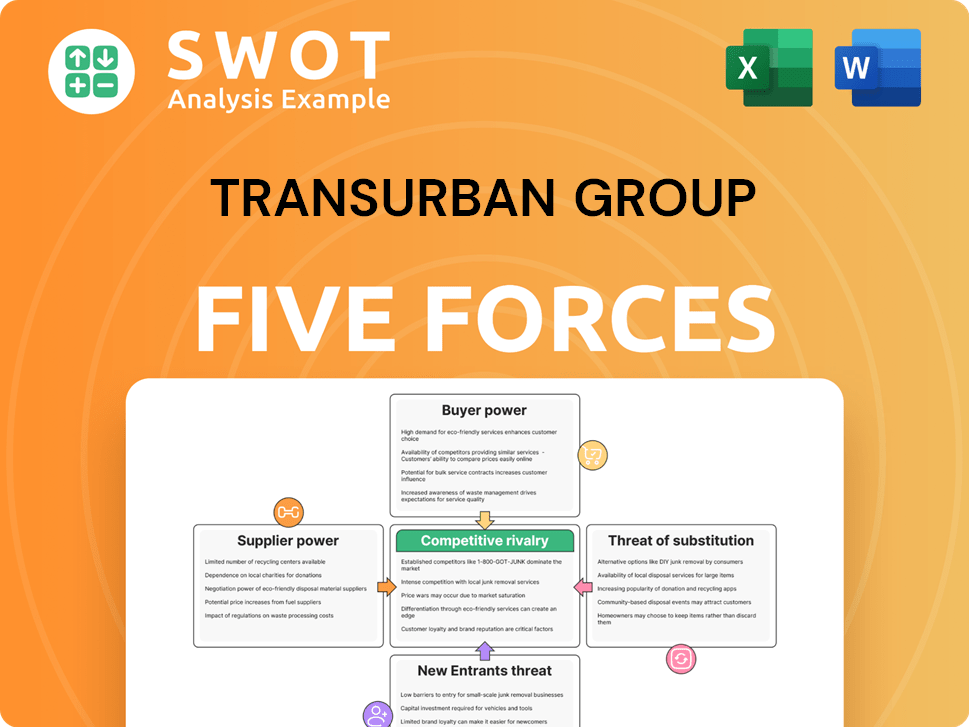
Related Blogs
- What are Mission Vision & Core Values of Transurban Group Company?
- What is Growth Strategy and Future Prospects of Transurban Group Company?
- How Does Transurban Group Company Work?
- What is Sales and Marketing Strategy of Transurban Group Company?
- What is Brief History of Transurban Group Company?
- Who Owns Transurban Group Company?
- What is Customer Demographics and Target Market of Transurban Group Company?
Disclaimer
All information, articles, and product details provided on this website are for general informational and educational purposes only. We do not claim any ownership over, nor do we intend to infringe upon, any trademarks, copyrights, logos, brand names, or other intellectual property mentioned or depicted on this site. Such intellectual property remains the property of its respective owners, and any references here are made solely for identification or informational purposes, without implying any affiliation, endorsement, or partnership.
We make no representations or warranties, express or implied, regarding the accuracy, completeness, or suitability of any content or products presented. Nothing on this website should be construed as legal, tax, investment, financial, medical, or other professional advice. In addition, no part of this site—including articles or product references—constitutes a solicitation, recommendation, endorsement, advertisement, or offer to buy or sell any securities, franchises, or other financial instruments, particularly in jurisdictions where such activity would be unlawful.
All content is of a general nature and may not address the specific circumstances of any individual or entity. It is not a substitute for professional advice or services. Any actions you take based on the information provided here are strictly at your own risk. You accept full responsibility for any decisions or outcomes arising from your use of this website and agree to release us from any liability in connection with your use of, or reliance upon, the content or products found herein.